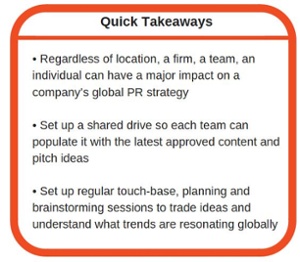 When I started working in PR, I didn’t own a smartphone. The first firm I worked for only had desktop computers, not laptops. Now, we’re more connected than ever. To communicate with colleagues, clients, media and influencers, I rely on email, phone calls, text, Microsoft Teams chat, Slack and Zoom video calls. There is no shortage of ways to be in touch and way more flexibility than the profession has ever had.
When I started working in PR, I didn’t own a smartphone. The first firm I worked for only had desktop computers, not laptops. Now, we’re more connected than ever. To communicate with colleagues, clients, media and influencers, I rely on email, phone calls, text, Microsoft Teams chat, Slack and Zoom video calls. There is no shortage of ways to be in touch and way more flexibility than the profession has ever had.
The world of PR has changed, especially in terms of how, when and where we communicate. This has opened up a new world for PR, quite literally. Regardless of location, a firm, a team, an individual can have a major impact on a company’s global PR strategy. Multinational brands often have separate PR and marketing teams in each country, looking to gain exposure in each of those markets. But, that can mean bursts of publicity – with no strategic alignment or red thread. I’ve had the opportunity to work on multiple global PR programs where we partner with clients’ disparate PR teams to ensure we’re all working toward the same overarching objectives.

While planning and executing global PR campaigns there are a few nuances to keep in mind to avoid potential hiccups and maximize results.
3 Tips for Managing a Global PR Partnership
1. Make the best use of time zones
This might be the most obvious piece of advice, but it’s a big one.
In general, be conscious of when you communicate with clients, colleagues, media or anyone else working in a different time zone. If you want to ensure someone sees your email first thing when they sign on, ensure your communication is marked urgent and has a very clear subject. Or, use the Boomerang function from Outlook email scheduler and schedule your email for a more convenient time.
Accommodate schedules as best you can. I try to book calls with European counterparts before noon, when possible. Sometimes a time just won’t work. While I am flexible at taking a 6 or 7 pm call with Australia – and might even head home early from the office to take it remotely – a call with the UK, Australia and the US, just might not work. In that case, break it up into two separate calls and use email or other communication channels to stay in touch as a group. And while some people might be fine with an early 7 am or late 7 pm call, always be sure to ask for preferences, because after hours calls might not work for everyone.
Ultimately, always remember where the other person is in his or her day and cater your communication to be most effective and respectful.
2. Recognize that one size does not fit all when it comes to media angles
Here in the U.S., Amazon is dominating headlines. But, Amazon doesn’t exist in all countries and is just emerging in some, like Australia. If our PR team here is pitching reporters on the future of retail, that story will look completely different in a different part of the globe. Keeping with the retail trends between U.S. and Australia, these regions start the back-to-school season at very different times of the year, so any outreach or thought leadership around that timeframe would be staggered in an editorial content calendar. With the holiday season now approaching, U.S. PR teams are preparing Black Friday and Cyber Monday plans, but these holidays aren’t relevant in all regions. Chinese PR teams, in the meantime, may be capitalizing on Singles Day instead.
It’s important to understand these nuances so one approach isn’t forced across all countries. There may be other differences; for example, there are more paid media placements and fewer earned opportunities in some countries. Or, perhaps there are fewer financial trade publications in one market compared to another. These factors should impact the PR metrics being set – as one region might have a higher likelihood of success simply based on the opportunities that exist.
3. Collaborate, collaborate, collaborate
With PR teams and client contacts miles and hours apart, it’s easy for things to be missed. One team doesn’t share their great idea for a pitch, so no one else knows about it. An opportunity is declined because the information needed is nowhere to be found. Balls might be dropped, but worse, opportunities are missed that no one even realizes existed.
Every PR team is working extremely hard, so why not maximize those efforts? Set up a shared drive so each team can populate it with the latest approved content and pitch ideas, so others can review and repurpose for their country. Set up regular touch-base, planning and brainstorming sessions to not only ensure alignment and keep everyone in the loop, but trade ideas and understand what trends are resonating globally and which might have stronger local components.
“Don’t let your best idea go unheard, lost or misinterpreted just because you didn’t feel empowered to collaborate with local leaders.”
While most of these tips apply to U.S.-oriented PR campaigns, there should be a greater focus on them when dealing with multiple countries and time zones. Don’t let your best idea go unheard, lost or misinterpreted just because you didn’t feel empowered to collaborate with local leaders. As we work day in and day out helping our clients differentiate to break through the noise, it’s mission critical that each company’s messaging platform resonates globally, not just as a one-off in a single market. If this is the case, it’s time to tap into your clients’ global reach and potential.
Need an agency to support your growing brand? Check out our NXT Stage Approach to find out how we can help.



